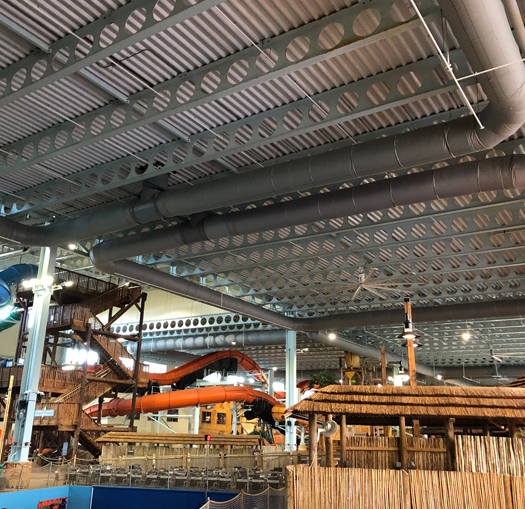5 Reasons to Consider Fabric Ductwork for Your Commercial HVAC System

Most of us go about our days without thinking about the maze of ductwork that helps us control our indoor environments, keeping us cool in the winter and warm in the summer. But those of us involved in designing, installing, and maintaining commercial HVAC systems need to consider the efficiencies, advantages, and potential problems of ductwork far more than the average person.
Air ducts got their start around 300 AD when the Romans used vertical tubes underneath floor tiles to heat rooms. Those tubes were connected to a wood furnace which sent warm air through the ducts into the rooms. In the 1900s, as comfort heating and cooling gained popularity, what we now recognize as modern air ducts were created to push warm and cool air into rooms. Traditionally, this ductwork was manufactured from sheet metal, using galvanized steel or aluminum. However, fabric dispersion systems have become a viable alternative for many applications, including indoor swimming facilities, gyms, convention centers, supermarkets, and food processing plants.
Here are 5 reasons why fabric ductwork can be a great choice:
- Lower materials and labor costs: The cost can be up to 80% less than metal, depending on the application. Labor time required to install custom fabric ductwork could be up to 10 times less than traditional metal. Additionally, savings on labor increases with the diameter of the ducts. For example, labor time to install a 60” diameter DuctSox is about the same as a 20” diameter DuctSox. Labor time savings means overall project time savings as well. For example, in a retrofit project, down time could be an issue.
- Low maintenance: In harsh environments, like the Kalahari Resort in Sandusky, OH, fabric ductwork is essentially the only choice. The waterpark opened in 2005 with 80,000 square feet and expanded another 93,000 square feet in 2008. Due to the harsh indoor pool environment, the metal support structure for the air distribution ductwork began to erode and required replacement in 2018, only 13 short years after the initial opening. Once a DuctSox system is installed, there is little to no ongoing maintenance required. What’s even better is that a fabric dispersion system can actually be commercially laundered, which can be important in applications with increaased hygiene standards.
- Noise control: With traditional metal ductwork, mechanical noise from airflow can be unacceptably loud in some applications. Using fabric duct for air distribution can deliver air quietly without any of the resonation found in metal ductwork. Additionally, a fabric sound attenuator could be installed for additional noise reduction if there is mechanical noise from the air handler.
- No risk of condensation: Condensation can form on metal ductwork and could cause problems like water damage, mold or mildew in areas surrounding the ductwork, and potentially rusting. Contrarily, fabric systems are condensation free.
- Aesthetically pleasing: Customization options are available with fabric ductwork. You can personalize your system with a logo, company name, slogan or a custom pattern.
Those are just a few of the benefits your next commercial building project could realize. When you need to consider ductwork, you may want to think about incorporating a fabric air dispersion system.
// about the author
 Kelly Patterson
Kelly Patterson
Kelly Patterson is a lifelong learner and the marketing director at the Hoffman family of companies. There is nothing she likes more than talking about commercial HVAC systems and extraordinary customer service.













